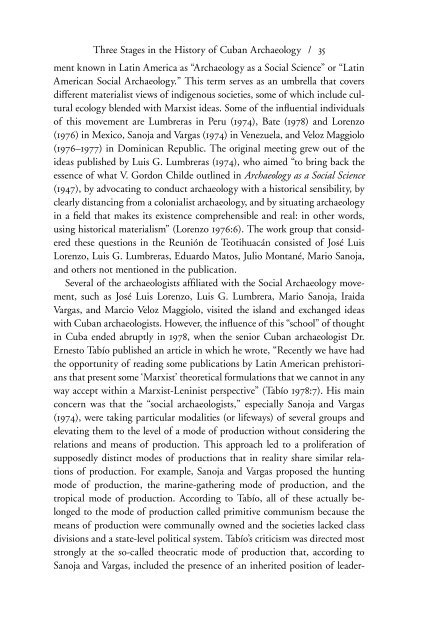Dialogues in Cuban Archaeology
by L. Antonio Curet, Shannon Lee Dawdy, and Gabino La Rosa Corzo
by L. Antonio Curet, Shannon Lee Dawdy, and Gabino La Rosa Corzo
You also want an ePaper? Increase the reach of your titles
YUMPU automatically turns print PDFs into web optimized ePapers that Google loves.
Three Stages <strong>in</strong> the History of <strong>Cuban</strong> <strong>Archaeology</strong> / 35<br />
ment known <strong>in</strong> Lat<strong>in</strong> America as “<strong>Archaeology</strong> as a Social Science” or “Lat<strong>in</strong><br />
American Social <strong>Archaeology</strong>.” This term serves as an umbrella that covers<br />
different materialist views of <strong>in</strong>digenous societies, some of which <strong>in</strong>clude cultural<br />
ecology blended with Marxist ideas. Some of the <strong>in</strong>®uential <strong>in</strong>dividuals<br />
of this movement are Lumbreras <strong>in</strong> Peru (1974), Bate (1978) and Lorenzo<br />
(1976) <strong>in</strong> Mexico, Sanoja and Vargas (1974) <strong>in</strong> Venezuela, and Veloz Maggiolo<br />
(1976–1977) <strong>in</strong> Dom<strong>in</strong>ican Republic. The orig<strong>in</strong>al meet<strong>in</strong>g grew out of the<br />
ideas published by Luis G. Lumbreras (1974), who aimed “to br<strong>in</strong>g back the<br />
essence of what V. Gordon Childe outl<strong>in</strong>ed <strong>in</strong> <strong>Archaeology</strong> as a Social Science<br />
(1947), by advocat<strong>in</strong>g to conduct archaeology with a historical sensibility, by<br />
clearly distanc<strong>in</strong>g from a colonialist archaeology, and by situat<strong>in</strong>g archaeology<br />
<strong>in</strong> a ¤eld that makes its existence comprehensible and real: <strong>in</strong> other words,<br />
us<strong>in</strong>g historical materialism” (Lorenzo 1976:6). The work group that considered<br />
these questions <strong>in</strong> the Reunión de Teotihuacán consisted of José Luis<br />
Lorenzo, Luis G. Lumbreras, Eduardo Matos, Julio Montané, Mario Sanoja,<br />
and others not mentioned <strong>in</strong> the publication.<br />
Several of the archaeologists af¤liated with the Social <strong>Archaeology</strong> movement,<br />
such as José Luis Lorenzo, Luis G. Lumbrera, Mario Sanoja, Iraida<br />
Vargas, and Marcio Veloz Maggiolo, visited the island and exchanged ideas<br />
with <strong>Cuban</strong> archaeologists. However, the <strong>in</strong>®uence of this “school” of thought<br />
<strong>in</strong> Cuba ended abruptly <strong>in</strong> 1978, when the senior <strong>Cuban</strong> archaeologist Dr.<br />
Ernesto Tabío published an article <strong>in</strong> which he wrote, “Recently we have had<br />
the opportunity of read<strong>in</strong>g some publications by Lat<strong>in</strong> American prehistorians<br />
that present some ‘Marxist’ theoretical formulations that we cannot <strong>in</strong> any<br />
way accept with<strong>in</strong> a Marxist-Len<strong>in</strong>ist perspective” (Tabío 1978:7). His ma<strong>in</strong><br />
concern was that the “social archaeologists,” especially Sanoja and Vargas<br />
(1974), were tak<strong>in</strong>g particular modalities (or lifeways) of several groups and<br />
elevat<strong>in</strong>g them to the level of a mode of production without consider<strong>in</strong>g the<br />
relations and means of production. This approach led to a proliferation of<br />
supposedly dist<strong>in</strong>ct modes of productions that <strong>in</strong> reality share similar relations<br />
of production. For example, Sanoja and Vargas proposed the hunt<strong>in</strong>g<br />
mode of production, the mar<strong>in</strong>e-gather<strong>in</strong>g mode of production, and the<br />
tropical mode of production. Accord<strong>in</strong>g to Tabío, all of these actually belonged<br />
to the mode of production called primitive communism because the<br />
means of production were communally owned and the societies lacked class<br />
divisions and a state-level political system. Tabío’s criticism was directed most<br />
strongly at the so-called theocratic mode of production that, accord<strong>in</strong>g to<br />
Sanoja and Vargas, <strong>in</strong>cluded the presence of an <strong>in</strong>herited position of leader-


















